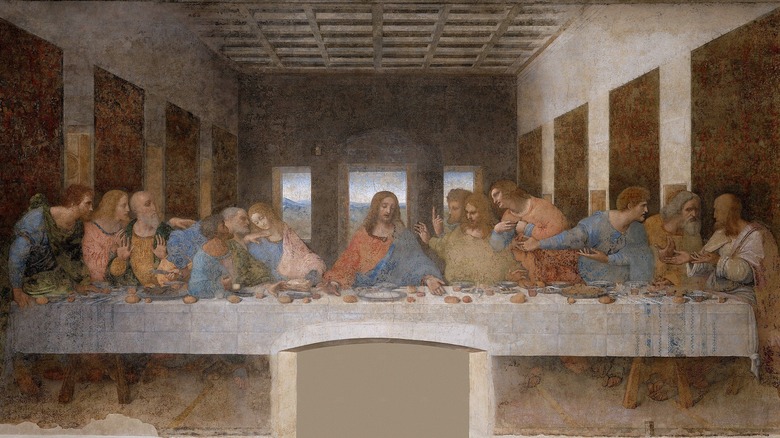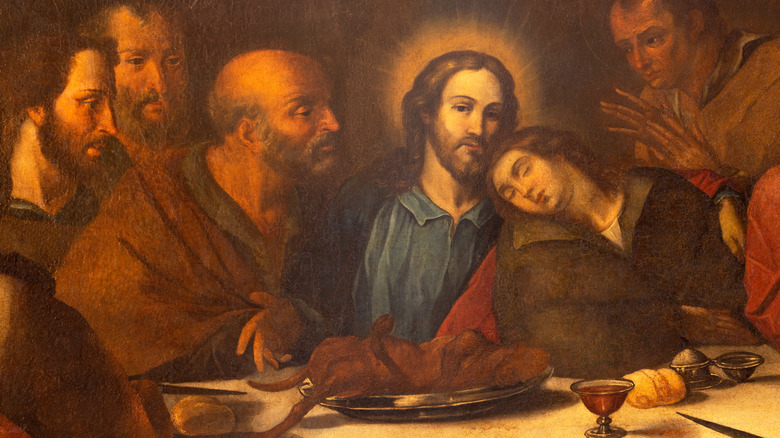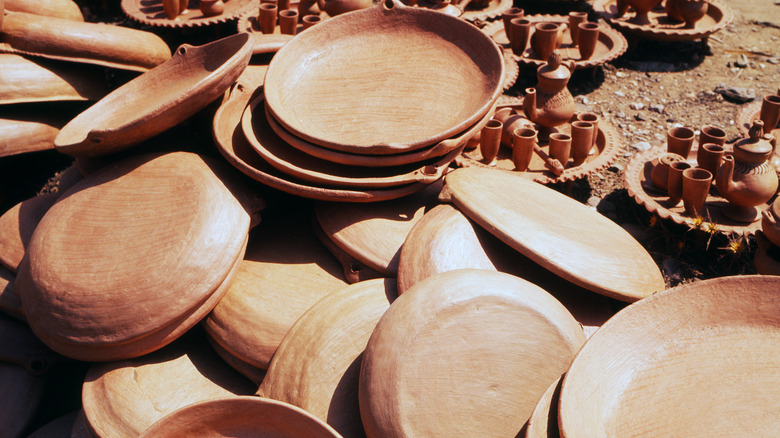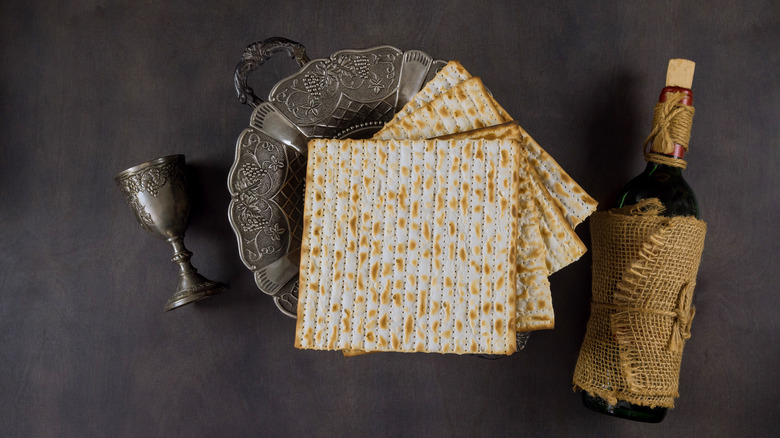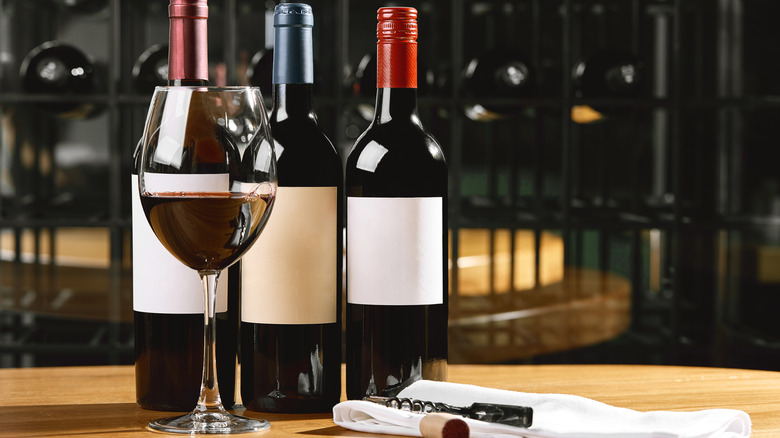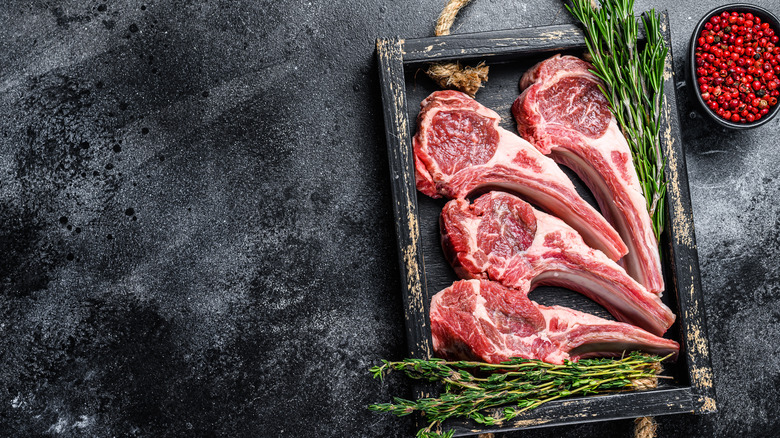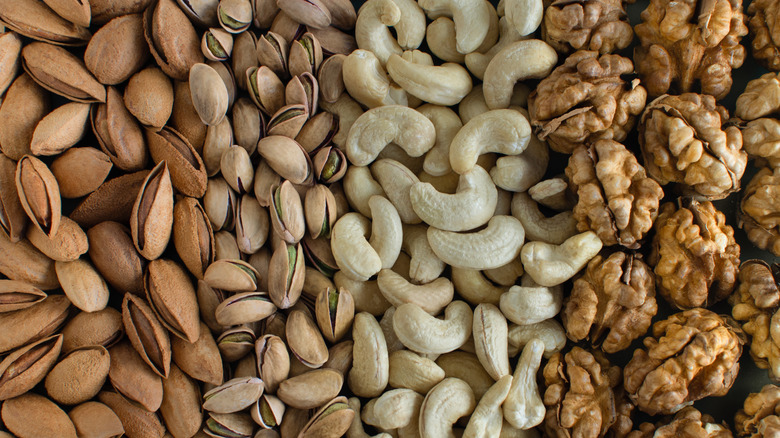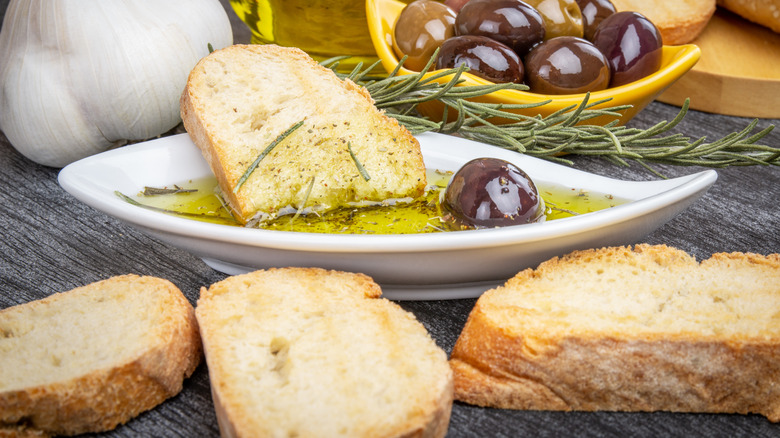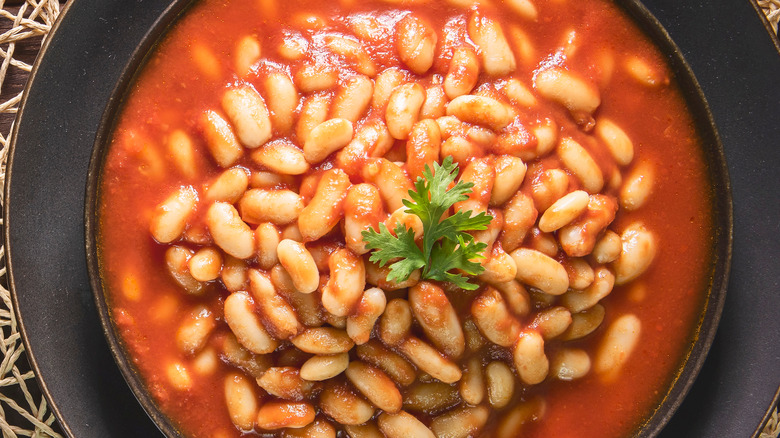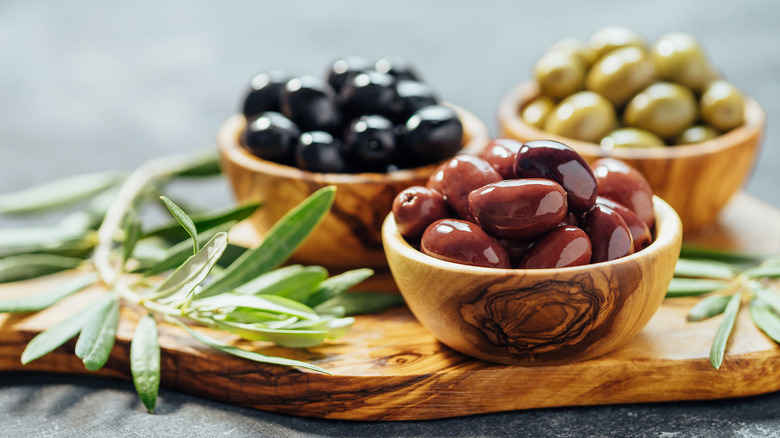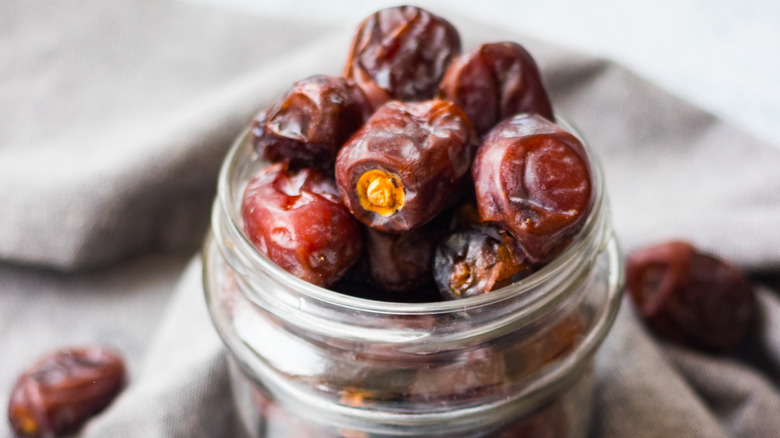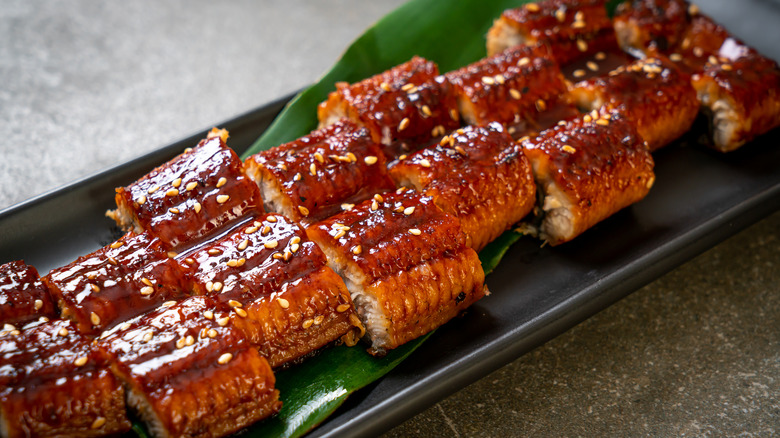What Jesus Really Ate At The Last Supper
Even if you're not intimately familiar with biblical history, you're probably at least generally aware of the Last Supper. That would be the last meal that Jesus shared with his disciples before he was crucified. It's the same supper where Jesus washed his disciples' feet and shared bread and wine with them as a depiction of his own body and blood.
And, if you're not aware of the Last Supper for religious reasons, your college art history class likely introduced you to Leonardo da Vinci's famous fresco depiction of the event, perhaps unsurprisingly also called "The Last Supper." The thing is, based on history and art, it's not entirely clear what, exactly, the meal included. Certainly, the Bible doesn't offer a full menu with accompanying recipes in any of the accountings of the event in the Gospels (the Biblical books of Matthew, Mark, Luke, and John).
But based on context clues, historical information on traditional Jewish meals of the time, and what the group was known to eat during other meals together, modern historians can make some highly educated guesses about what was part of the meal. So if you're looking to re-create the event as part of your future Easter celebrations or are just curious about the contents of the meal itself, here's what Jesus really ate at the Last Supper.
The Last Supper was a communal meal
One thing to remember about shared meals during Biblical times is that they were often communal, and were certainly depicted as such in the Bible (via the University of Notre Dame). This isn't just in the sense that multiple people sat around a table to eat together, however. They would also be seen typically sharing from the same dishes and generally without utensils, per Owlcation. Think of it more as a historical hot pot meal or ancient fondue experience where everyone would dip into and eat out of the same dishes.
This is important in the Biblical sense because Jesus specifically refers to "The one who has dipped his hand into the bowl with me will betray me," in Matthew 26:23, to make it clear that Judas was going to betray him to the authorities, who would them crucify Jesus. So if you're trying to replicate the scene of the Last Supper, you need to set up a communal meal with shared dishes and plenty of handwashing.
And to really set the scene, consider ditching your normal table and chairs and opt, instead, for a low table and cushions. Archaeologist Generoso Urcluoli told Live Science that "At that time in Palestine, food was placed on low tables and guests ate in reclining position on floor cushions and carpets." Just be careful who you let share your dishes with you — it's best to avoid "friends" like Judas.
Dishes were made out of stone to avoid impurities
When it comes to keeping things authentic, you might also want to pull out your stoneware or terra cotta dishes. Plastic or modern ceramic plates, spoons, and cups weren't exactly around more than 2,000 years ago, after all. And given that Jewish food laws were focused on avoiding various unclean and impure substances, along with the fact that no one was blessed with modern dishwashers and hot running water, things get complicated. Archaeologist Generoso Urcluoli told Live Science that stone dishes were most likely what was used at the Last Supper. "Jews that observed the rules of purity used stone vessels because they were not susceptible to transmitting impurity," he said.
In all likelihood, Jesus and his disciples were observing the rules of purity, as they almost certainly saw themselves as observant and faithful Jews (via PBS). On the off chance that they weren't being careful about their dinnerware, however, another possible option would have been "fine red terra sigillata pottery," according to Urcluoli. That's not because it's less likely to transmit impurity, but apparently, because it was simply on-trend at the time.
The bread was probably unleavened
Unleavened bread is often flat and hard, as it's made without any yeast to help it rise. And certainly, just as unleavened bread isn't most people's first pick when they're craving carbs, it probably wasn't the first choice for Jesus and his crew most of the time. But here's the deal — according to Apologetics Press, the bread appearing at the Last Supper (and we know Jesus would have eaten bread and wine with his crew, as all of the Gospels tell us so), was almost certainly unleavened. This is because according to at least three of the Gospels (Matthew, Mark, and Luke), Jesus and his disciples were gathering to eat the feast of the Passover, an important Jewish holiday. And, specifically, the Passover feast is called "The Feast of Unleavened Bread."
The Passover was accounted in the Bible in Exodus 12:1-28, where verses 18-20 include the directives from God, "For seven days no yeast is to be found in your houses. And anyone, whether foreigner or native-born, who eats anything with yeast in it must be cut off from the community of Israel. Eat nothing made with yeast." Seems like a pretty clear command, especially if you want to remain part of the group. Every year after, the feast upheld the same standards. Thus, assuming Jesus and his crew were eating a Passover feast, it can be assumed that the carbs Jesus broke as a symbol of his own body was, in fact, unleavened bread.
Wine was almost certainly on the Last Supper table
Once again, the Gospels make it very clear that wine was included as part of the Last Supper. You need to look no further than Matthew 26:27-29, where it says that Jesus "took the cup, gave thanks and offered it to them saying, 'Drink from it, all of you. This is my blood of the covenant, which is poured out for many for the forgiveness of sins. I tell you, I will not drink of this fruit of the vine from now on until that day when I drink it anew with you in my Father's kingdom."
Granted, the passage doesn't specifically say "wine," but rather says "fruit of the vine." But given the fact that grape juice wasn't historically used at feast events of the time, and that Jesus and his disciples had no qualms about imbibing in a little vino, according to Christianity.com, it's a fairly safe bet that the content of the cup in question was wine. Now whether it was red, white, or some other, more specific varietal of wine, no one can say for sure. But you have to assume if the wine was meant to be a representation of Jesus' blood, it was probably a rather dark red.
Lamb may have been on the menu
Just as there's some debate over whether the bread Jesus broke with his disciples was leavened or unleavened, there is also a question over whether lamb would have made it onto the Last Supper menu. The Gospel of Luke seems to make it clear that yes, in fact, the men gathered and ate lamb. In Luke 22:7, it states, "Then came the day of Unleavened Bread on which the Passover lamb had to be sacrificed."
Seems pretty clear, especially because it wasn't like people went around sacrificing animals without putting the meat to use afterward. So certainly, at first glance, it seems safe to assume Jesus and his disciples ate lamb. The debate comes with the Gospel of John, which in John 19:14 states that Jesus was crucified on the "day of the Preparation for the Passover." In other words, the meal the disciples shared with Jesus would have taken place before the Passover feast and the sacrifice of the lamb. The Biblical Archaeology Society makes a solid argument for John's account, while the Apologetics Press maintains that the Last Supper was a Passover feast. Ultimately, lamb is controversial here.
More than 2,000 years later, it's hard to know for sure, but with two solid arguments, you can probably get away with serving lamb at your supper either way. If you like lamb, go ahead and enjoy yourself. But if you're not a fan of the meat, don't feel bad about skipping it.
Bitter herbs with nuts was a classic table staple
Think about the time and place where the Last Supper would have taken place: Jerusalem, more than 2,000 years ago. People tended to eat what was available and easy to procure and prepare. It's not like there were big box grocery stores or drive-thru restaurants, after all. Herbs and nuts both fall into the "available and easily procured" categories, and, according to Live Science, were common foods of the time. Archaeologists Generoso Urciuoli and Marta Berogno suspect that it was pistachios that made the table with Jesus and the disciples, along with the bitter herbs.
Even though the archaeologists didn't try to specify what types of herbs that may include, we have some good guesses. According to Bible Hub, the phrase "bitter herbs" in the Bible could refer to a variety of things, including watercress, parsley, and endive. These bitter herbs were part of the original Passover feast detailed in Exodus 12:8, where the Jewish people are told "to eat the meat roasted over the fire, along with bitter herbs, and bread made without yeast." So assuming, of course, that the meal shared by Jesus and his disciples was a Passover feast, it can be extrapolated that bitter herbs were involved.
Fish sauce was probably served at the Last Supper
In an interview with Live Science, archaeologists Generoso Urciuoli and Marta Berogno indicate that tzir, a kind of fish sauce that riffed on the ancient Roman favorite known as garum, was also likely present at the Last Supper. Unless you're a huge fan of fish, the idea of a fish sauce being added to the meal may not sound all that appetizing. But apparently, tzir was widely used like a condiment, akin to fishy ketchup.
According to NPR, garum was made by loading up fish with salt until the mixture was fermented. Sometimes the people making garum didn't even bother to use whole fish, but would instead use only the guts. The fermentation process would create an incredibly potent, flavorful sauce that was a cornerstone of Roman cuisine for all segments of society.
As such, it can be assumed that, for feast days, there would be some form of tzir or garum available as a condiment. And according to food historian Sally Grainger, the sauce was incredibly versatile, "After the fish sauce is made, it was then turned into compound sauces — with honey, with wine, with vinegar, with other herbs, with oil" (via NPR). Hopefully, whatever sort of tzir was shared by Jesus and his disciples had a better flavor than how fermented fish guts sounds to many modern ears.
Cholent, a dish of stewed beans, was popular
Beans aren't necessarily a type of food that screams, "ancient Roman fare," to some, but the bean-basted cholent was quite a popular dish back when Jesus walked with his disciples. According to Live Science, this slow-cooked dish of beans was a widely enjoyed type of fare during festivities, so it would make sense that it would be eaten on a feast day like Passover.
According to NPR, cholent also offered a way for practicing Jews to respect the Sabbath's commandment not to work or cook, while still being able to prepare and enjoy a hot meal. Essentially, beans (and sometimes meat, vegetables, and spices) are cooked together over low heat in a long process that commences before the Sabbath. Thus, there's no need for any cooking or preparation on the Sabbath itself.
Now, what type of beans would have been used for the Last Supper? That's not entirely clear and was likely based on whatever beans were available. That said, food historian Gil Marks told NPR that dishes like Boston baked beans are an Americanized version of a cholent made by Sephardic Jews, a group that includes people of Middle Eastern descent. So, even if you aren't up for making your own slow-cooked cholent, you could always offer a symbolic (although clearly not entirely authentic) nod to tradition by providing a bowl of Boston baked beans. Maybe you could even share the similarly-named candy with your guests. Or not.
Olives and olive oil were plentiful
According to Faithward, on any given day it's likely that Jesus included olives and olive oil in his diet. It's reasonable to think that one or both of these items were probably present on the Last Supper table, too. Olive trees are plentiful in Israel, which means the readily available fruits made for an excellent addition to meals. Olive oil was often used to help flavor leavened bread or as a dip.
Archaeologists Generoso Urcluoli and Marta Berogno told Live Science that they believed there would have been olives served with hyssop, a medicinal herb that's in the same family as mint. According to Masterclass, Romans used hyssop to help protect themselves from illness and negativity. When the plant appears in the Bible, it's typically in reference to cleanliness or ritual sacrifice. Given that the Passover meal featured the ritual sacrifice of a lamb and was almost certainly focused on cleanliness, it's natural to conclude that hyssop would be part of the meal shared by Jesus and his disciples in the Last Supper.
Diners may have had dried dates or fig charoset
For all the savory items that were part of the Last Supper, it makes sense that there would be something sweet on the table to help balance the palate. While it's unlikely there would be desserts served like Americans are used to for big feasts (sorry, no pies, cookies, or cakes), local fruits would certainly have been provided as a treat. Crops common to the area included grapes, figs, and pomegranates. However, assuming Passover took place in early spring, it's unlikely that they would have been in season at the time. That means dried figs or dates would have been the most likely candidates for the table.
Live Science notes that dates would have been possibly served as charoset, a type of thick spread that's still popular today as a Passover dish. This side typically consists of dried dates or figs, sometimes augmented with apples, nuts, spices, and juices from citrus fruit. It's often served as a topping for unleavened bread, making it perfect as a dessert or sweet side for Jesus and the apostles.
There was no eel at the Last Supper
If you've always assumed that Jesus and his disciples only shared bread and wine, the full spectrum of foods that made the Last Supper table may then be a surprise. Now, if you've been taking your Last Supper menu cues from Leonardo da Vinci's famous painting, you may think it was a rather richer feast. But you'll potentially be disappointed to learn that eel, which is present in the painting, definitely wasn't served as part of this famous dinner, per Gastronomica. The main reason? Eel isn't considered kosher. If we assume that Jesus and his disciples followed Jewish food laws, there's no way they would have chowed down on this snake-like fish.
This may come as a surprise considering that eels have both fins and scales, both requirements necessary for a creature to be considered a kosher fish. But according to an answer provided by Rabbi Baruch S. Davidson on Chabad.org, the scales eels have don't meet the strict definition laid out by Jewish law. He writes that the Torah specifies that a scale needs to be easily removable before it's considered kosher. Eel scales don't fit that bill. So, for the eel-averse, you can take a deep breath of relief. If you're trying to recreate an authentic Last Supper meal, you don't have to learn how to cook eel.
